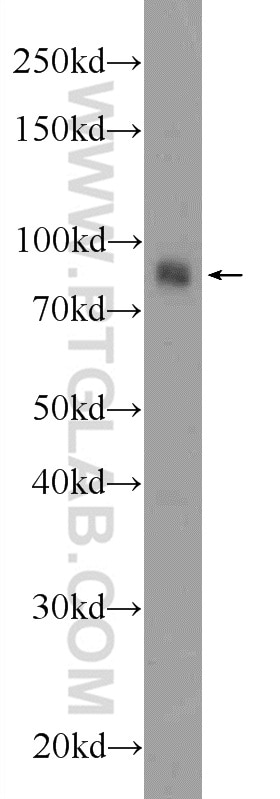AFAP1L1 Polyklonaler Antikörper
AFAP1L1 Polyklonal Antikörper für WB, ELISA
Wirt / Isotyp
Kaninchen / IgG
Getestete Reaktivität
Affe, human
Anwendung
WB, ELISA
Konjugation
Unkonjugiert
Kat-Nr. : 23909-1-AP
Synonyme
Geprüfte Anwendungen
| Erfolgreiche Detektion in WB | COS-7-Zellen |
Empfohlene Verdünnung
| Anwendung | Verdünnung |
|---|---|
| Western Blot (WB) | WB : 1:500-1:1000 |
| It is recommended that this reagent should be titrated in each testing system to obtain optimal results. | |
| Sample-dependent, check data in validation data gallery | |
Produktinformation
23909-1-AP bindet in WB, ELISA AFAP1L1 und zeigt Reaktivität mit Affe, human
| Getestete Reaktivität | Affe, human |
| Wirt / Isotyp | Kaninchen / IgG |
| Klonalität | Polyklonal |
| Typ | Antikörper |
| Immunogen | AFAP1L1 fusion protein Ag21006 |
| Vollständiger Name | actin filament associated protein 1-like 1 |
| Berechnetes Molekulargewicht | 768 aa, 86 kDa |
| Beobachtetes Molekulargewicht | 75-86 kDa |
| GenBank-Zugangsnummer | BC125093 |
| Gene symbol | AFAP1L1 |
| Gene ID (NCBI) | 134265 |
| Konjugation | Unkonjugiert |
| Form | Liquid |
| Reinigungsmethode | Antigen-affinitätsgereinigt |
| Lagerungspuffer | PBS with 0.02% sodium azide and 50% glycerol |
| Lagerungsbedingungen | Bei -20°C lagern. Nach dem Versand ein Jahr lang stabil Aliquotieren ist bei -20oC Lagerung nicht notwendig. 20ul Größen enthalten 0,1% BSA. |
Hintergrundinformationen
Actin Filament-Associated Protein of 110 kDa (AFAP-110/AFAP1) is an adaptor protein with multiple protein binding motifs that is known to function as both an actin binding protein and a cSrc activating protein. A homology search of AFAP1 recently identified AFAP1L1 which has a similar sequence, domain structure and cellular localization. AFAP1L1 is highly expressed in human breast, colon and brain tissue. AFAP1L1 interacts with cortactin and involves the invadosomes formation. AFAP1L1 as a prognostic marker has a role in the progression of spindle cell sarcomas.
Protokolle
| PRODUKTSPEZIFISCHE PROTOKOLLE | |
|---|---|
| WB protocol for AFAP1L1 antibody 23909-1-AP | Protokoll herunterladen |
| STANDARD-PROTOKOLLE | |
|---|---|
| Klicken Sie hier, um unsere Standardprotokolle anzuzeigen |


